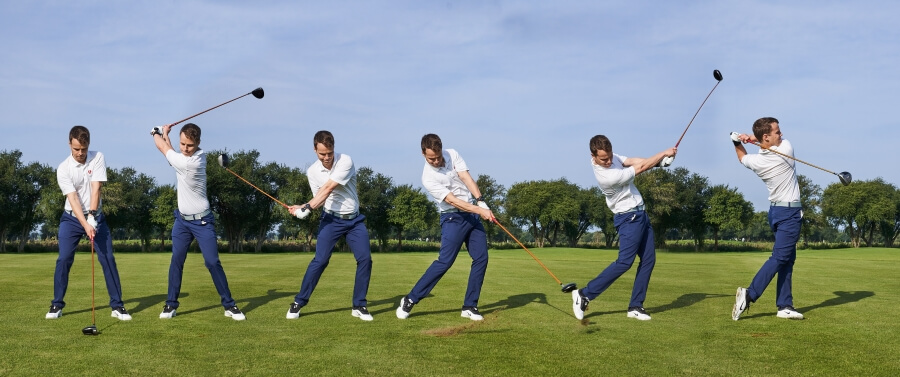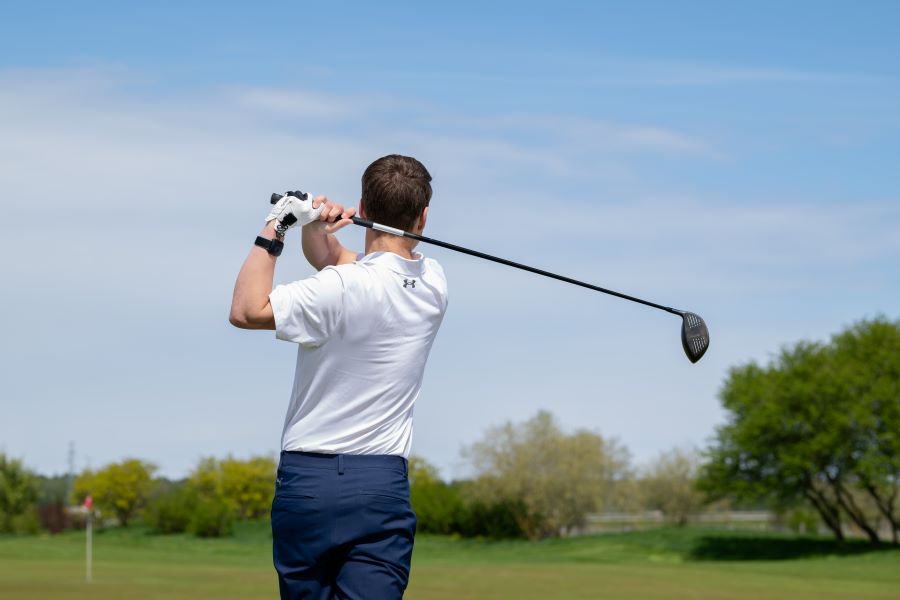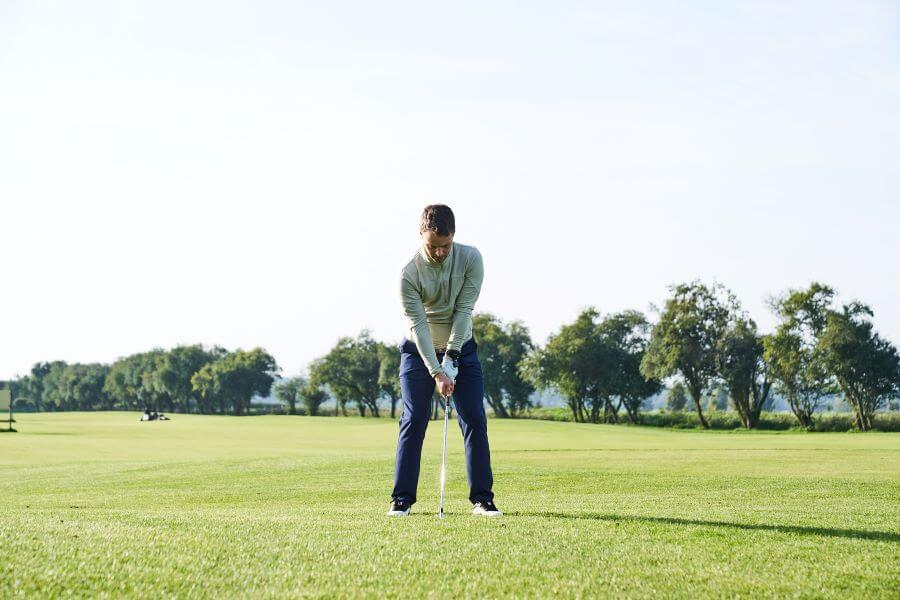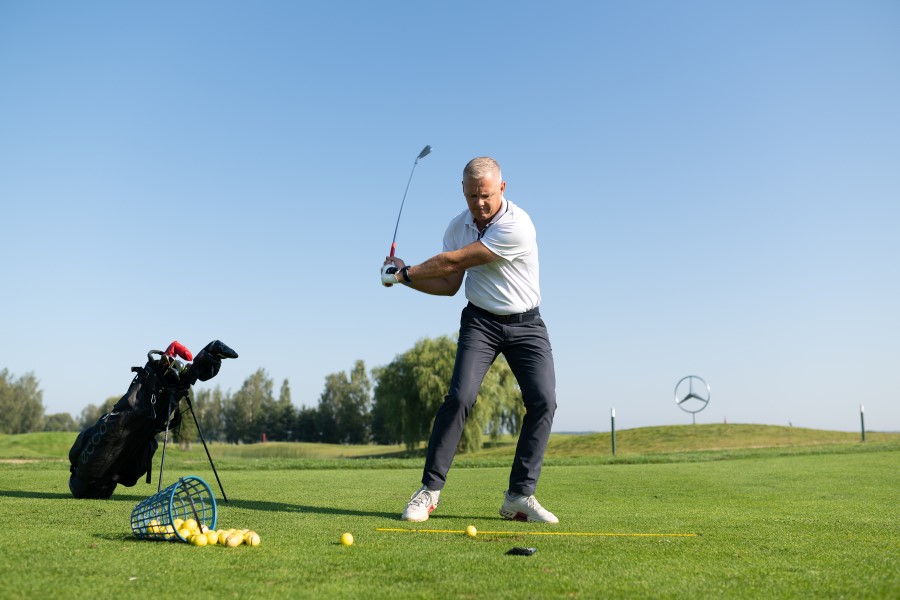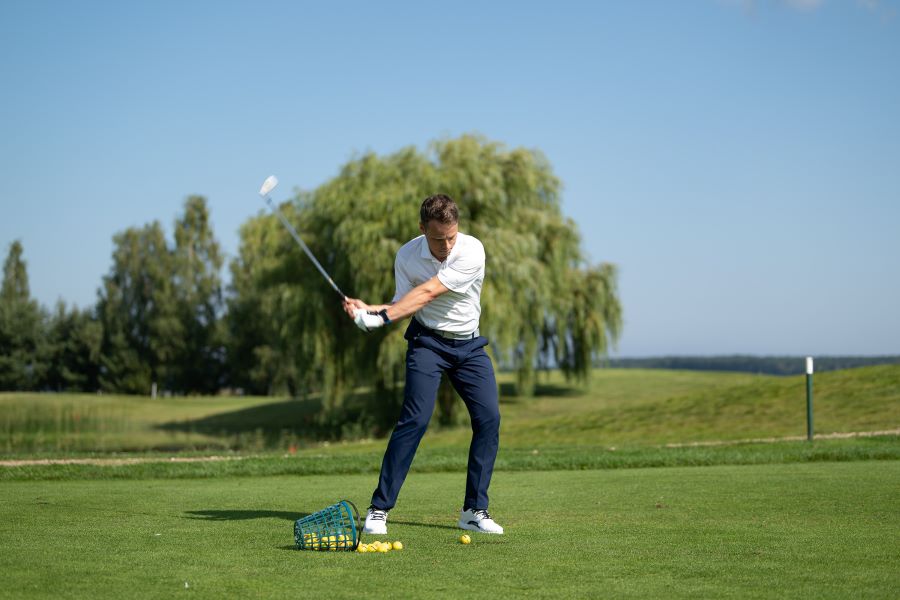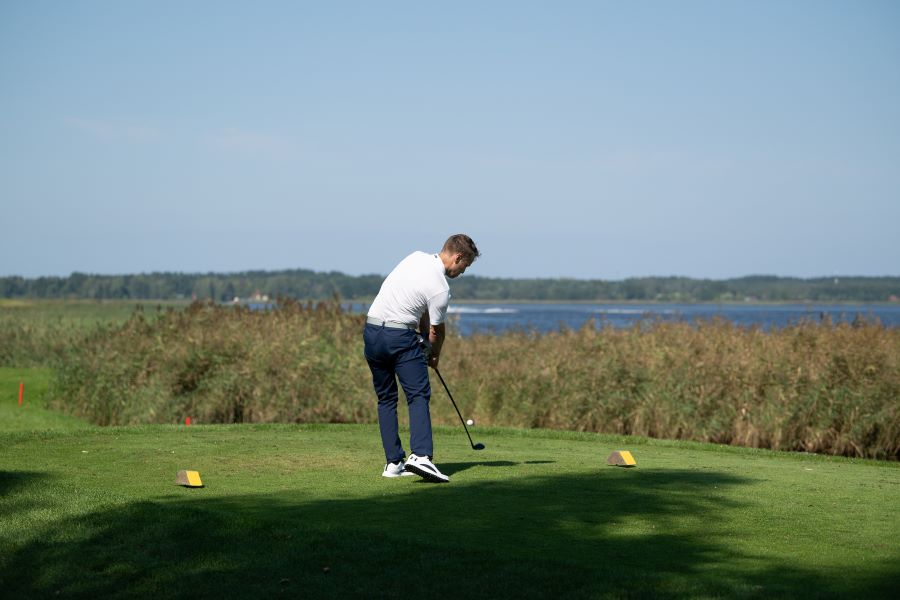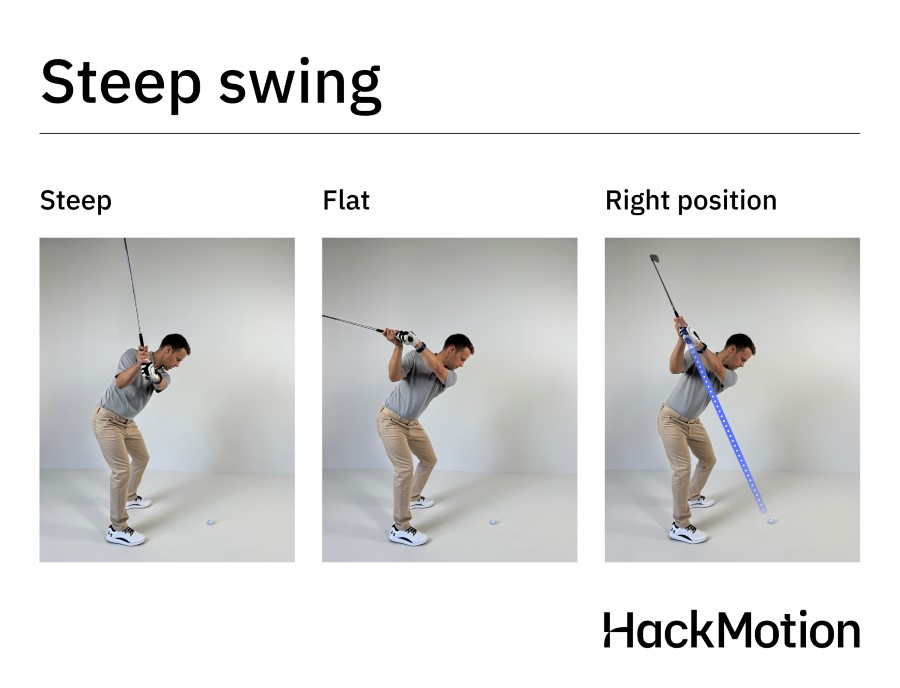Stop Early Extension in Your Golf Swing: 7 Proven Steps & Drills to Fix It
Early extension in the golf swing is something many golfers aren’t even aware of. If you haven’t heard of early extension, you may recognize it as when amateur golfers stand up as they approach the ball.
Early extension occurs instead of rotating and staying back. The pelvis moves closer to the ball, the spine angle is lost, and poor contact along with a loss of power is the result.
If you’re ready to fix early extension in your golf swing and start making better contact, here are the drills and tips you need to get it done.
How to Stop Early Extension (Key Takeaways)
Early extension in golf isn’t always a quick fix. It’s something that will require consistent practice at the range to groove into your swing.
If you want to save this guide and reference it later, here are a few things to keep in mind about early extension for now:
- If your clubface is in the correct position at the top of your backswing, you’ll be less likely to early extend on the downswing. Focus on proper wrist angles and having a square clubface.
- The lower body needs to rotate and pull you through the ball. If you stop rotating and rely only on your arms, you’ll extend early and stand up through impact.
- Pay attention to your weight transfer between the feet and from heel to toe. Practice drills where you hit shots from the center of your feet.
- Strengthen your core to help pull you through the golf ball without extending or standing up.
- Wearing your HackMotion while working on early extension can help identify wrist position issues throughout your swing.
If you prefer to learn by watching a video, this complete guide from Rob Cheney will help you fix early extension in your golf swing.
Contents
What Causes Early Extension in Golf?
There are a few causes behind early extension, and they include:
- Lack of lower body flexibility, mainly tightness in the hips, hamstrings, or lower back.
- Incorrect weight transfer, failure to properly shift weight.
- A clubface that is too open at the top and a last-minute effort to fix it.
- Fear of hitting the ground.
- Over the top swing path.
- Poor stability in the core muscles.
Regardless of the cause of your early extension, the fixes will all involve creating more awareness of the move you are making and creating space for the club to swing through and stay on the proper path.
Here are the best ways to fix early extension in your golf swing.
7 Practical Steps to Fix Early Extension in Your Golf Swing
1. External Rotation of the Trail Arm
If you watched the video above from Rob Cheney, he explains that the key to fixing early extension in the golf swing is to get the trail arm into the correct position.
As important as it is to find this position on the downswing, it’s equally important to get the position correct from the start.
Cheney refers to the starting position of the trail elbow as a “give blood position”. If you can get your trail arm rotated so the pit of your elbow is pointing up, it creates a space for the arm to travel the entire length of the downswing.
This space is your key to ensuring you don’t have to extend early and you won’t stand up on the way to the golf ball.
2. Focus On Head Movement
Most of the time, golfers focus on their legs and knee bends when trying to fix early extension in the golf swing.
In this video from Eric Cogorno, you can take a look at how focusing on your head movement may be a better approach.
For those who struggle with early extension, the head lifts up as you swing through the impact position. The spine angle changes and the head moves out of its starting position.
Try to pay attention to the up and down movement of the head and leave it in the same place you start.
3. Get Your Weight Centered
Weight shifts around throughout the golf swing. Most of that weight movement is lateral from center to right to left (for a right-handed golfer).
However, those who struggle with early extension tend to move their weight toward the toes on the downswing.
This weight shifting to the toes makes it very difficult to have enough room to square the clubface. In addition, you’ll lose power and often hit the shot to the right of the target.
As you shift your weight in your swing, get your weight more on the center of your feet and even towards the inside of the feet. This will help you keep your spine angle the same throughout.
4. Clubface Square at the Top
When your clubface is square at the top, lots of good things happen in the golf swing.
The angle of your lead wrist controls the clubface.
After analyzing more than 1,000,000 golf swings, we know that most golfers have too much extension in their lead wrist as they get to the top of their backswing.
From this position, there is a lot of work to do to get the clubface square at the golf ball.
The natural move for many players is to move their weight forward, straighten up, and try and flip their wrists.
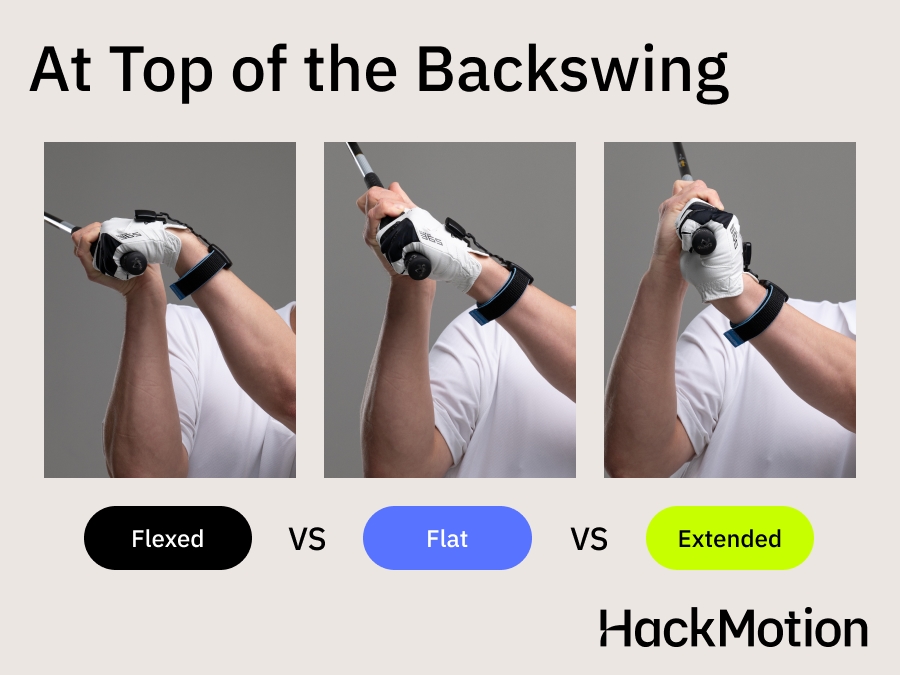
If you can just work on flattening the lead wrist at the top of the swing, it could put everything else into place for you.
Wearing your HackMotion as you work on this lead wrist positioning makes it easier to see where your mistakes are. It’s like having a coach with you at the range.
5. Keep the Backside Pushing Out on the Downswing
When you want to fix something in the golf swing, it’s often best to do the opposite and then tweak and make adjustments. If you can feel both sides of the issue then you can hopefully find the middle ground.
Golfers who extend early stand-up and push their backside in as they move towards the golf ball.
If you want to stop this, think about your backside moving a little away from the ball on the downswing. The best way to practice this is to put an alignment stick behind you as you set up to hit a golf ball.
While you swing back to the target, keep your backside touching the alignment stick. As you swing down, push into that alignment stick; don’t lose connection with it.
You’ll feel your core start to rotate and turn better.
6. Chest Down to the Ground
Throughout the backswing, your chest will rotate slightly up and away from the target.
However, when you swing through the ball, the chest needs to rotate down toward the ground. This motion allows you to stay more over the ball and compress it.
To work on this you can use this drill from Chris Ryan where he holds a golf club over his chest to indicate the shoulders are pointing down at setup.
As you swing back the club rotates up and then as he moves toward impact the club is pointing down again.
If you are struggling with early extension, the club actually starts to point up as you swing through impact. You can work on this drill when you are at home.
7. Keep the Knee on the Toe Line
Take a look at your knee action in your golf swing. If the trail knee moves out past the toe line on the downswing, it’s going to cause you some issues.
For this, you will want to focus on keeping that little bit of flex in the trail knee and not letting it straighten or move forward toward the golf ball.
A great drill to help with this process is to put a golf ball under the toe of the trail foot. The golf ball in this position makes it much easier to feel that incorrect early extension motion.
You’ll be forced to stay back and hit the ball from a more powerful position.
Final Thoughts
At this point, you have all the information and drills you will need to stop early extension in your golf swing.
If you hit a lot of thin shots and shots that trail to the right, you could be extending too early in the swing. Head to the driving range with your HackMotion and an alignment stick, and that should be all you need.
Watch some videos of professionals moving through impact and how their spine angles stay in the same position the entire time. You’ll learn a lot about the golf swing and what it takes to get the ball up in the air.





